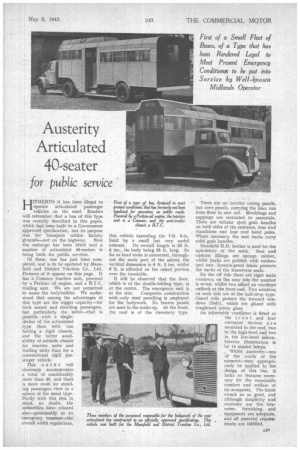Austerity Articul ated 40-seater
Page 25

If you've noticed an error in this article please click here to report it so we can fix it.
for public service HITHERTO it has been illegal to operate articulated passenger vehicles on the road. Readers will remember that a bus of this type was recently described in this paper, which had been built to a Government approved specification, but its purpose was for transport within factory grounds—not on the highway. Now the embargo has been lifted and a number of articulated 40-seaters is being built for public services,
Of these, one has just been completed, and is to be operated by Mansfield and District Traction Co., Ltd. Pictures of it appear on this page. It has a Commer tractive unit, powered by a Perkins oil engine, and a B.T.C. trailing unit. We are not permitted to name the bodybuilder. We understand that among the advantages of this type are the bigger capacity—for both seated and standing passengers, but particularly the, latter—that is possible with a singledecker of the articulated type than with one having a rigid chassis, and the better availability of suitable chassis for tractive units and trailing units than for a conventional rigid passenger vehicle.
This outfit will obviously accommodate a total of considerably more than 40, and there is more room for standing passengers than in a saloon of the usual type. Partly with this idea in mind, no doubt, the authorities have relaxed also—presumably as an emergency measure—the overall width regulations, this vehicle exceeding the 7-ft. 6-in. limit by a small but very useful amount. Its overall length is 33 ft. 6 ins., its body being 25 ft. long. So far as head room is concerned, throughout the main part of the saloon the vertical dimension is 6 ft. 5 ins. whilst 6 ft. is afforded on the raised portion over the turntable.
It will be observed that the door, which is of the double-folding type, is at the centre. . The emergency exit is at the rear. Composite construction with, only steel panelling is employed for the bodywork. No beaten panels are used in the make-up. At the front, the roof is of the clerestory type. 'There are no interior casing panels, but cove panels, carrying the lino, run from floor to seat rail. Mouldings and cappings are restricted to essentials. There are tubular steel grab handles on both sides of the entrance, four roof stanchions and four roof hand poles. Where necessary the seat backs carry solid grab handles.
Mansfield H.B. leather is used for the Upholstery of the seats. Seat and cushion fillings are sponge rubber, whilst backs are padded with rubberized hair. Scratch-proof fabric protects the backs of the transverse seats.
On the off side there are eight main windows; on the near side the number is seven, whilst two afford an excellent outlook at the front end. Two windows on each side are of the -half-drop type. Guard rails protect the forward windows (fodr), which are glazed with toughened safety glass.
An adjustable ventilator is fitted at the front and four extractor devices a r e mounted in the roof, two in the high-level and two in the low-level saloon. Interior illumination is by 14 shaded lainps.
Whilst austerity—one of the words of the moment—may appropriately he applied to the design of this bus, it lacks no features necessary fdr the reasonable comfort and welfare of its occupants. The finish struck us as good, and although simplicity and economy are the. 'keynotes, furnishing and equipment are adequate, and all essential requirements are fulfilled.




















































